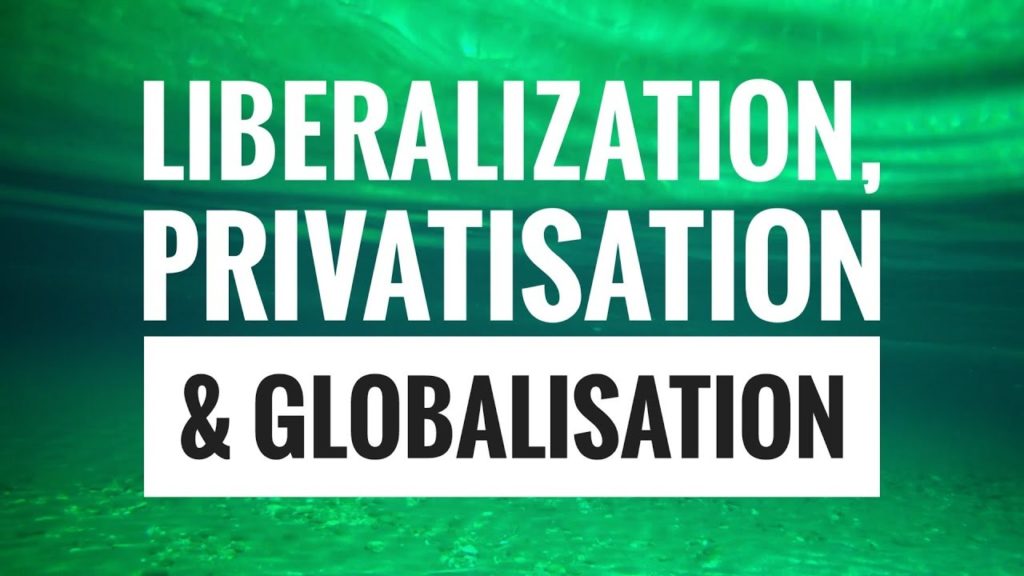Owing to deteriorating trade balance, economic and financial crisis in early 1990s, India had to borrow foreign exchange from IMF and comply with the conditions imposed by it such as stabilisation and structural stability programme, reduction of trade barriers, revision of fiscal and monetary policies, active role of market and integration of the Indian economy with the world economy. The three basic elements of economic reforms were Liberalisation Privatisation and Globalisation (also known as LPG strategy) of the Indian economy.

Goals of LPG Refoms
- To achieve high rate of growth of national and per capita income;
- To achieve full employment;
- To achieve self-reliance;
- To reduce the inequality of income and wealth;
- To reduce the number of people living below the poverty line;
- To develop a pattern of society based on equality and absence of exploitation
Liberalisation Privatisation and Globalisation
Liberalisation Privatisation and Globalisation are the three constituents of economic reforms. Let us discuss them one by one.
Liberalisation
Liberalisation refers to shifting of license dominated regime to de-licensing, deregulation and de-bureaucratisation. A liberal policy adopted on both domestic and external fronts which included the following measures:
- Removal of Industrial Licensing: All industrial licensing was abolished except for 18 industries relating to security and strategic concerns, social sectors, hazardous chemicals, environmental reasons and items of elitist consumption industries. At present only five industries are under compulsory licensing mainly on account of environmental, safety and strategic considerations
- Dereservation of SSI Items: To promote domestic and global competition, reservation of Small-scale industry (SSI) items is being reduced gradually since 1990s. Currently, no items are reserved exclusively for SSI.
- Withdrawal of MRTP Act: The MRTP Act has been withdrawn and the MRTP commission stands disbanded. This enabled business houses to undertake expansion and establishment of new businesses as well as undertake mergers, amalgamations and takeovers.
Privatisation
Privatisation refers to any process that reduces the involvement of the state/public sector in economic activities of a nation. Policies were framed to increase the role of private sector in the process of development.
The four forms of Privatisation are:
- Denationalisation: It implies complete transfer of state ownership of productive assets into private hands
- Joint Venture: It implies partial induction of private ownership from 25 to 50 per cent or even more in a public sector enterprise, depending upon the nature of the enterprise and state policy. The basic aim is to improve efficiency, productivity and profitability of the firms.
- Workers’ Co-operative: Under this form of privatization, a loss-making public sector firm is transferred to the workers. The basic purpose is that workers besides receiving wages for work, would also be entitled to a share in ownership dividend. Since workers’ personal interest is linked to the interest of the enterprise, the workers are likely to work hard to increase productivity so that they can earn more.
- Disinvestment: It is also known as Token Privatisation or deficit privatization. It involves sale of 5 per cent to 10 per cent shares of a profit-making public sector enterprise in the market. The objective is to garner revenue to reduce budget deficits.
Globalisation
Globalisation is the process of integrating the various economies of the world without creating any barriers in the flow of goods and services, technology, capital and labour/human capital. Thus it is the process of economic integration of the country with the rest of the world. Globalisation has four components:
- Reduction of trade barriers in the form of custom duties or quantitative restrictions or quotas so as to permit free flow of goods and services among different economies
- Creation of an environment in which free flow of capital (or investment) can take place between nation-states
- Creation of an environment for free flow of technology
- Creation of an environment in which free flow of labour or human resources can take place among different countries of the world.
To achieve the objectives of globalization, the government undertook following measures:
- Reduction of custom duties
- Removal of quantitative restrictions or quotas on exports
- Adjustment of exchange rate
- Facilitating foreign investment
- Encouragement of foreign technology
We hope you liked this article on Liberalisation Privatisation and Globalisation. Here are some useful articles for you to read next:
Download this article as PDF
Click to go to RBI Grade B Preparation Page